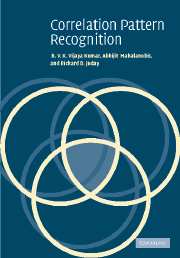Book contents
7 - Optical considerations
Published online by Cambridge University Press: 06 August 2009
Summary
Introduction
In this chapter we will consider how light is used to carry and process information. To perform correlation pattern recognition optically, we begin with coherent light with the right beam characteristics. We impress a signal upon the beam with one spatial light modulator (SLM), alter the propagation of the beam with a second SLM so that information is preferentially passed through the system and gathered at a location in the output plane, and detect and identify any information that might have been on the input beam. Accordingly we shall examine coherent light sources, SLMs, noise, and detection methods. Polarization of light is a particular point of interest, since many of the extant SLMs operate by altering the polarization of the light. Light polarization is a proper subset of statistical optics, and for a more complete description we refer the reader to Goodman [77] and to O'Neill [78]. Diffraction phenomena are also examined in this chapter, as they are responsible for the Fourier transforming properties needed for an optical correlator.
A knowledge of the physics of light and light modulators can be used to place information onto a beam and to cause its propagation to convert the information to a usable (i.e., detectable) form. The light typically used in the correlators discussed in this book has idealized properties. It is almost monochromatic (i.e., of single wavelength), almost fully polarized (this concept will be explained in later sections), and often enters the processing system as almost planar waves.
- Type
- Chapter
- Information
- Correlation Pattern Recognition , pp. 244 - 294Publisher: Cambridge University PressPrint publication year: 2005



